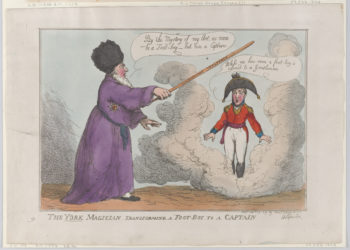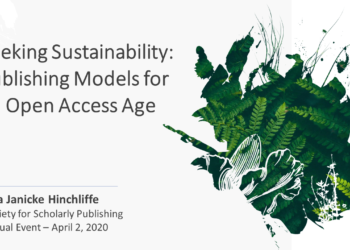Editor’s Note: Today’s post is by Julian Wilson, Sales and Marketing Director at IOP Publishing
Simplicity is the ultimate sophistication, Leonardo De Vinci
Scholarly publishing is in the midst of the most dramatic transformation seen in centuries. Making research openly available to all has become a priority for many, and transformative agreements (TAs) have moved to the forefront as a practical way to accelerate the transition to open access (OA) publishing.
According to figures from the ESAC initiative, there has been a 60% year on year increase in TAs. In 2021, 184 TAs were made worldwide compared to 114 in 2020, and the upward trend is continuing as 103 TAs have been listed in the first four months of this year. TAs, which have been gaining ground in Europe for several years, are now also appearing in the US and Canada and spreading across other countries around the world. In January next year, our first TA with the Electronic Information for Libraries consortium (EIFL), which represents mainly Lower-Middle-Income Countries, will come into effect.
It is no surprise that TAs are growing in popularity, as they support the growing number of authors who want to make their research openly available with the support of their institution. A recent global study has found that 67% of early career researchers (ECRs) say that making their work openly available is important to them. Yet, 70% have been prevented from publishing OA because they have not been able to access the necessary monies from funding agencies to cover the cost. When asked why ECRs favor OA publishing, agreeing with its principles and benefitting from a wider readership were cited as the top two reasons.

So, the interest is clear, and so is the uptake. But are all TAs made equal and do they make good on their promises? TAs set out to ‘transition’ or ‘transform’ existing library spend on subscriptions to academic journals towards OA publication fees. I’ve taken a closer look across the industry and assessed the aspirations of various TAs and compared them to our own TA approach here at IOP Publishing (IOPP).
For TAs to deliver on their promise of enabling OA at scale they must deliver on the basic notion of transformation as a first principle. Looking at restricted or capped TA models, where the number of articles that can be published under the agreement is limited, we believe that the transition to full and immediate OA at scale will not be achieved.
At IOPP our starting principle is to offer Unlimited Read and Publish (R&P) TAs. They are not a perfect solution, but they foster a dramatic shift towards OA publishing. The graph below shows the increase in research published OA with us in the countries where we have TAs.

Based on our own data, we see that the rate of OA publishing at Institutions which have unlimited TAs with us will comfortably exceed 80% of all the articles published by eligible authors.
Unlimited publishing agreements smooth the administrative burden for librarians, as they no longer need to be concerned about the number of articles being published OA. They don’t have to worry about additional costs should authors publish more than anticipated. Another benefit is that uncapped publishing agreements limit APCs in the wild, as the cost of OA publishing from sources that are not easily tracked are brought into centrally managed library or institution budgets.
How do unlimited TAs benefit authors?
As policies and funder mandates increasingly require publishing on an OA basis, unlimited OA publishing offers authors a simple route to compliance. To make it even easier, cOAlition S has developed a Journal Checker Toolwhich shows authors the publishing options that are supported by their funder’s OA policy.
Unlimited TAs also empower authors because they remove the need to source APC funds as funding OA is agreed at the institutional level. Capped TAs limit author choice in that once the cap is reached, they either need to find a way to fund the APC or publish another way. An author should retain the option to publish in their journal of choice and we seek to facilitate that wherever possible in our TAs.
Although we believe that TAs are the most effective means of transitioning toward OA at scale, we do recognize that they are not without their flaws. Many contracts remain too costly for institutions in lower and lower-middle income countries creating inequalities for their affiliated authors. We offer robust APC waivers but appreciate that this doesn’t offer the same level of access to OA publishing.
What about ‘Gold’?
When we look across the R&P agreement landscape, it is common to find that the right to publish in fully OA or gold OA journals is excluded. For example, some TAs only enable publishing in hybrid journals. In fact, according to all the listings in the ESAC TA registry, 42.2% of TAs do not include gold OA titles.
The argument for not including gold OA journals is that the transition is not required for fully OA titles. While there is some logic in this argument, we believe that the exclusion of fully gold OA journals diminishes the user experience and adds complexity rather than removing it. From our standpoint we welcome the submission of OA papers across our entire portfolio regardless of venue and see that as a compelling reason to include gold OA titles in our agreements. We want the publishing process to be as simple as possible for our authors and we want to reduce administration for librarians as much as possible. Our standard offer going forward will be to include both hybrid and gold titles for publishing in all our agreements and we hope that this will become the norm across the wider industry.
Different roads
Conversations around other models to support the transition toward OA continue throughout the industry, but how do they compare? We have considered Subscribe to Open (S2O) for some of our journals. This model uses payments for subscription-only journals to convert gated access to full OA. In other words, the publisher agrees to make content openly available for a year so long as the subscribing institutions continue to pay their subscription fees. Although we value this model, it doesn’t offer a transition at the same rate as unlimited R&P agreements.In this scenario, the journal is dependent on the collective action or goodwill of the subscribing institutions to maintain a secure base of funding to run a high-quality journal. Also, this reliance makes it harder to grow and invest in developing a journal as titles can go in and out of OA and keeping track of the status of journals is difficult for authors and librarians to manage.
Diamond OA models, where an organization or collective sponsors the entire cost of publishing and neither authors nor readers pay fees, are another route to OA. Although this model offers flexibility to the diverse needs of authors, it requires access to sufficient funds and a willingness to sustain this arrangement for a prolonged period of time. We currently publish three Diamond OA journals together with funding partners. We also participate in the Sponsoring Consortium for Open Access Publishing in Particle Physics (SCOAP3)— a consortium led by CERN which includes over 3,000 libraries and research institutes. SCOAP3 provides Diamond OA for high-energy physics authors eliminating the financial barriers of making their work openly accessible to the wider science community. Contrary to the conventional model where libraries and other subscribers pay publishers for access to journal articles, the SCOAP3 consortium collects funds directly from subscriber institutions and then makes payments to publishers based on the number of articles published OA. This allows high-energy physics papers to be published OA at no direct cost or additional burden to authors. Although we believe these models support greater diversity in the publishing ecosystem, this approach remains relatively uncommon and unproven longer term and again, scale is an issue.
As we transition toward open research, we are always willing to consider additional possibilities and models. At the end of last year, we started discussing a new agreement with a longstanding library partner, the Max Planck Digital Library. Reading fees had been reducing over several years due to previously acquired rights and so something akin to an APC publishing model was required. After a short and collaborative negotiation, we began trialing a new agreement which enables both parties to not only customize a model that is specific to their requirements, but also assess its efficacy as the agreement progresses. The agreement is midway through its first year and we’ll continue to assess if the deal delivers on the thing that matters most to us: to support the transition to unlimited open access to research.
So, whilst many approaches and models exist, we believe that the one that offers the most effective shift to a more open future at scale is a TA that offers inclusive and unlimited publishing. It provides a simple and transparent framework to accelerate the move to open access in a way that is sustainable for both libraries and publishers. Genuine transformative agreements must maximize OA publishing capability, remove payment barriers for authors, move subscription funds to publishing, and increase efficacy for library staff. We believe that author choice should remain the north star in the evolution of open access publishing models. Simplicity in a world of complexity should be admired and not avoided.
Author’s note: This post has been updated to correct a typo that erroneously indicated that IOPP’s transformative agreement with the Electronic Information for Libraries (EIFL) would be EIFL’s first transformative agreement. In fact, EIFL has struck transformative agreements with The Company of Biologists, IWA Publishing, and the European Respiratory Journal since 2021.
Discussion
10 Thoughts on "Guest Post — Why Transformative Agreements Should Offer Unlimited Open Access Publishing"
This already happened on the world wide web. If open = free, it will lead to a decrease of price awareness (that something can and should be treated as a precious object of value), erosion of buying readiness and – as has happened with subsidized news media – the end product of the effort will be affected as well (lack of neutrality and biased writing to please the subsidizers or at minimum a concentration of efforts around topics that ensure funding). I hope that I am wrong and the same won’t happen to OA.
Forgive my churlish nit-picking regarding a minor point, but “simplicity is the ultimate sophistication” – Leonardo da Vinci? Really? or is this just one of the thousands of dodgy quotations that abound on the internet, with utterly made-up attribution? It doesn’t sound remotely authentic to me …
Sounds more like Colin Chapman to me.
Inclusive and unlimited publishing is a key component of a successful TA. The Association for Computing Machinery (ACM) launched their own TA initiative in 2020, based on a sustainable model built with a group of leading universities including MIT and Carnegie Mellon. A key feature is unlimited read and unlimited publish, with pricing based on a tiered system centred on past publication history. Max Planck was an early signatory.
Like Ms. Williams, I am concerned about what happens to the idea of value when “everything is free”, but even more so I am concerned with what happens when, years from now, the institutions funding “free OA” for the readers and authors walk away for policy reasons, or simply fail in their own enterprises and cannot afford the bills, and the authors and readers have gotten used to the idea that they don’t have to pay to publish or read. What happens then?
I fully support OA and TAs to fund it, and I dream of a situation where we could endow permanent Platinum/Diamond OA for everyone, but we’re not there, I’m not sure how we get there, and it seems to me like an awful lot of eggs are being put in one basket.
Full Quote from Leonardo Da Vinci : “Simplicity is the ultimate sophistication.
When once you have tasted flight, you will forever walk the earth with your eyes turned skyward, for there you have been, and there you will always long to return.
Learning never exhausts the mind.
Art is never finished, only abandoned.
Painting is poetry that is seen rather than felt, and poetry is painting that is felt rather than seen.
The human foot is a masterpiece of engineering and a work of art.
It had long since come to my attention that people of accomplishment rarely sat back and let things happen to them. They went out and happened to things.
I have been impressed with the urgency of doing. Knowing is not enough; we must apply. Being willing is not enough; we must do.
As a well-spent day brings happy sleep, so a life well spent brings happy death.
Water is the driving force of all nature.”
Interesting post and a big Chapeau for IoPP for their efforts in making OA publishing a reality. However, capped TA’s are the result of an imbalance between library budgets and OA publication costs. With ever increasing numbers of publications and often not equally increasing library budgets, what is IoPP going to do? How are they going to match an unlimited TA, increasing publication numbers and more or less fixed library budgets?
This makes me wonder if TA’s really are the best funding model for OA? It is very noble to remove the need for authors to find APC funds but, in addition to other downsides of removing price awareness mentioned above, wouldn’t price awareness make authors weigh up where best to put their limited resources. This would not only have an effect on the ever increasing number of publications – and accompanying ever increasing costs of publishing, but also improve the quality of published papers because authors would make sure the publication is worth their (financial) investment.
I am aware of many counterarguments to this solution (low and middle income authors, early career vs established career authors, differences in APCs etcetera). However, I do think increasing publication numbers should be part of the discussion and I’m curious how IoPP is going to incorporate this into their view on uncapped TA’s.
We would welcome the correction of an error in this article. The author incorrectly says that the first TA with the Electronic Information for Libraries (EIFL) will come into effect in January next year. In fact, from 2021 EIFL agreements with The Company of Biologists, IWA Publishing, and the European Respiratory Journal provide free access and publishing. This year another agreement with the Association for Computing Machinery also provides free access and publishing. Additionally, agreements with Cambridge University Press and SAGE provide for paid access and unlimited open access to publishing.
Six other publishers provide free open access publishing to EIFL partner countries.
We encourage more publishers to contact us about transformative agreements.



